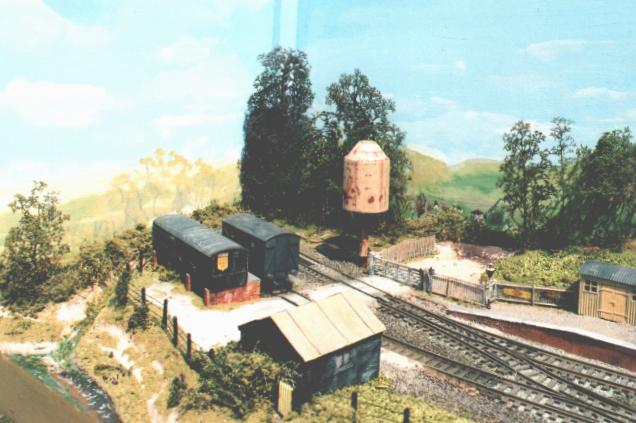 |
"Next to the station entrance was a crossing
gate through which a
narrow track led to a small yard used only by a feed merchant."
indentThere are many uses for a head-shunt
like this but one of the most useful, operationally speaking, is to find some reason to
shunt something into it regularly. It had been intended to place the cattle dock
here but it was felt that access over a running track was unlikely - too high a chance of
stray cattle disrupting things - so this ex-4wheeled coach body was used as a typical feed
store instead. The fact that on this layout the siding faces the opposite way to
the goods yard only adds to the shunting interest. It should be possible to
shunt a complete goods without "running round" more than once - but I never
managed it during testing...
indentThe canvas-roofed timber shed in the foreground is in
fact the shed housing the branch's inspection trolley. They cropped up on most
branchlines somewhere or other; the best photographed being that at Fairford upon which
this model is based. The gate would have been installed to allow railway staff to
inspect the river bank regularly for erosion. No doubt it was handy for fishing when
the stationmaster was elsewhere...
indentWhen railway companies had finished with their old rolling stock they could always find someone who would pay a few pounds for a body to use as a shed or store. At many locations across the Great Western the cattle feed merchants "Silcocks" (among others), used an old coach body like this, propped up on a timber or brick base, to store bags of feed delivered by rail and distributed by a carrier. The body is based on the old Ratio GWR 4-wheeled brake 3rd kit but with additions such as a properly panelled "ducket" and better rain strips. For conversion to a secure store, windows were either boarded up with timbers or replaced with timber or steel sheet. The supports are blocks of plywood covered in brick paper, the nearer two being longer to support a loading platform on the track side. (Lorries would have been loaded via the tail gate from the double doors on this side.) Perhaps a set of steps up to the guard's door might have been a nice addition but owing to price considerations it remained one of those things on the "nice idea if I had the time" list !
| Previous photograph in series | Back to "Upper Isis Room" entrance | Next photograph in series |